Weekly Tutorial Writing: University Business Development Module
VerifiedAdded on 2023/01/11
|41
|8694
|29
Homework Assignment
AI Summary
This document presents a student's comprehensive weekly tutorial writing assignment, focusing on business development concepts. The assignment covers various topics, including a case study on Volvo Cars Belgium, exploring the role of information systems in customer service and how IT can assist an auto dealer. It then delves into management information systems (MIS), examining the need for managers, management levels, and the objectives of using information systems in organizations. The assignment further analyzes the benefits of IoT, explores the structure of the MIS department, and discusses the skills needed for the head of MIS. Additionally, the assignment includes IT/IS applications at different management levels, the difference between functional and project managers, and how information systems transform global business. The document provides detailed answers, analysis, and examples for each task, offering insights into various aspects of business development.

WEEKLY TUTORIAL WRITING 1
University
Student name
Weekly tutorial writing
Date
University
Student name
Weekly tutorial writing
Date
Paraphrase This Document
Need a fresh take? Get an instant paraphrase of this document with our AI Paraphraser
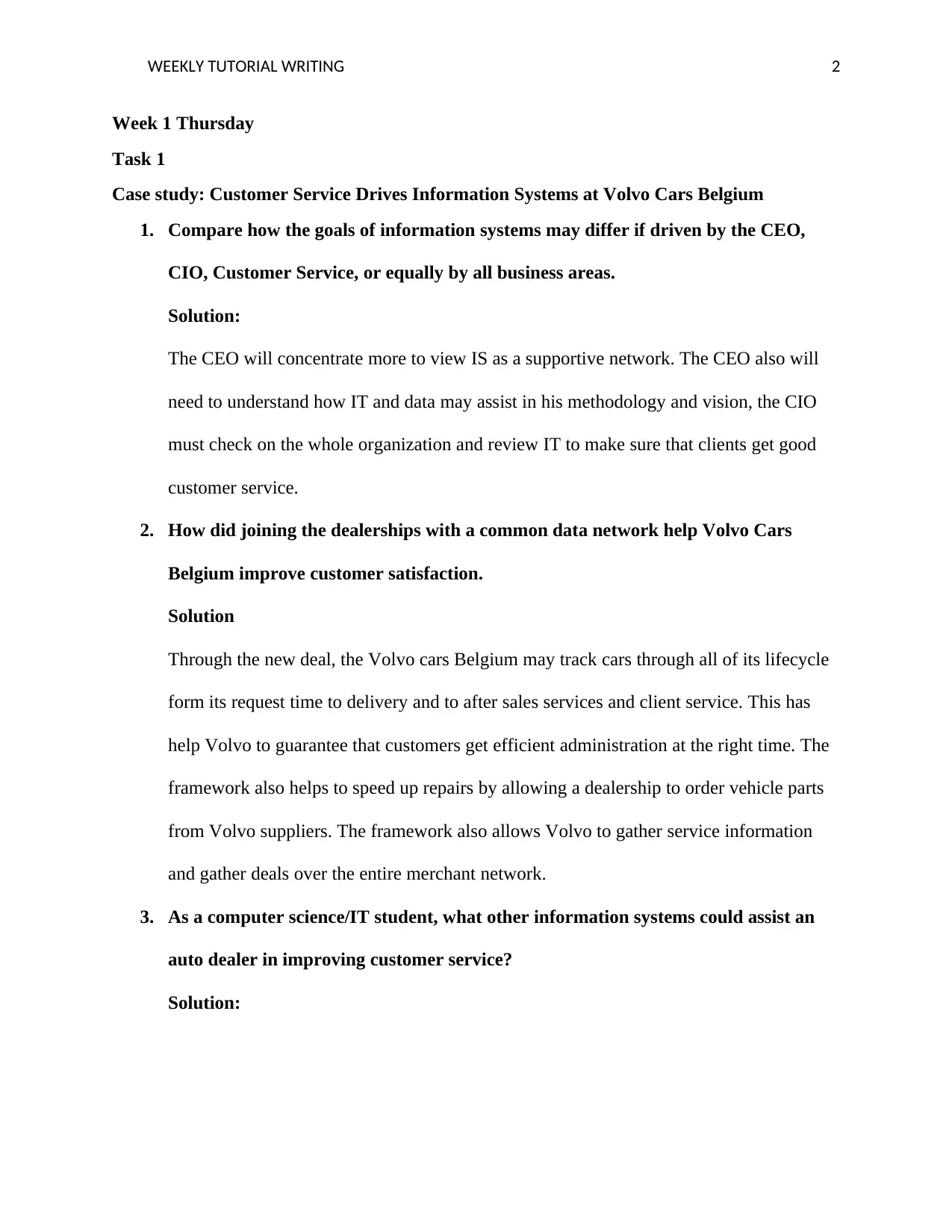
WEEKLY TUTORIAL WRITING 2
Week 1 Thursday
Task 1
Case study: Customer Service Drives Information Systems at Volvo Cars Belgium
1. Compare how the goals of information systems may differ if driven by the CEO,
CIO, Customer Service, or equally by all business areas.
Solution:
The CEO will concentrate more to view IS as a supportive network. The CEO also will
need to understand how IT and data may assist in his methodology and vision, the CIO
must check on the whole organization and review IT to make sure that clients get good
customer service.
2. How did joining the dealerships with a common data network help Volvo Cars
Belgium improve customer satisfaction.
Solution
Through the new deal, the Volvo cars Belgium may track cars through all of its lifecycle
form its request time to delivery and to after sales services and client service. This has
help Volvo to guarantee that customers get efficient administration at the right time. The
framework also helps to speed up repairs by allowing a dealership to order vehicle parts
from Volvo suppliers. The framework also allows Volvo to gather service information
and gather deals over the entire merchant network.
3. As a computer science/IT student, what other information systems could assist an
auto dealer in improving customer service?
Solution:
Week 1 Thursday
Task 1
Case study: Customer Service Drives Information Systems at Volvo Cars Belgium
1. Compare how the goals of information systems may differ if driven by the CEO,
CIO, Customer Service, or equally by all business areas.
Solution:
The CEO will concentrate more to view IS as a supportive network. The CEO also will
need to understand how IT and data may assist in his methodology and vision, the CIO
must check on the whole organization and review IT to make sure that clients get good
customer service.
2. How did joining the dealerships with a common data network help Volvo Cars
Belgium improve customer satisfaction.
Solution
Through the new deal, the Volvo cars Belgium may track cars through all of its lifecycle
form its request time to delivery and to after sales services and client service. This has
help Volvo to guarantee that customers get efficient administration at the right time. The
framework also helps to speed up repairs by allowing a dealership to order vehicle parts
from Volvo suppliers. The framework also allows Volvo to gather service information
and gather deals over the entire merchant network.
3. As a computer science/IT student, what other information systems could assist an
auto dealer in improving customer service?
Solution:
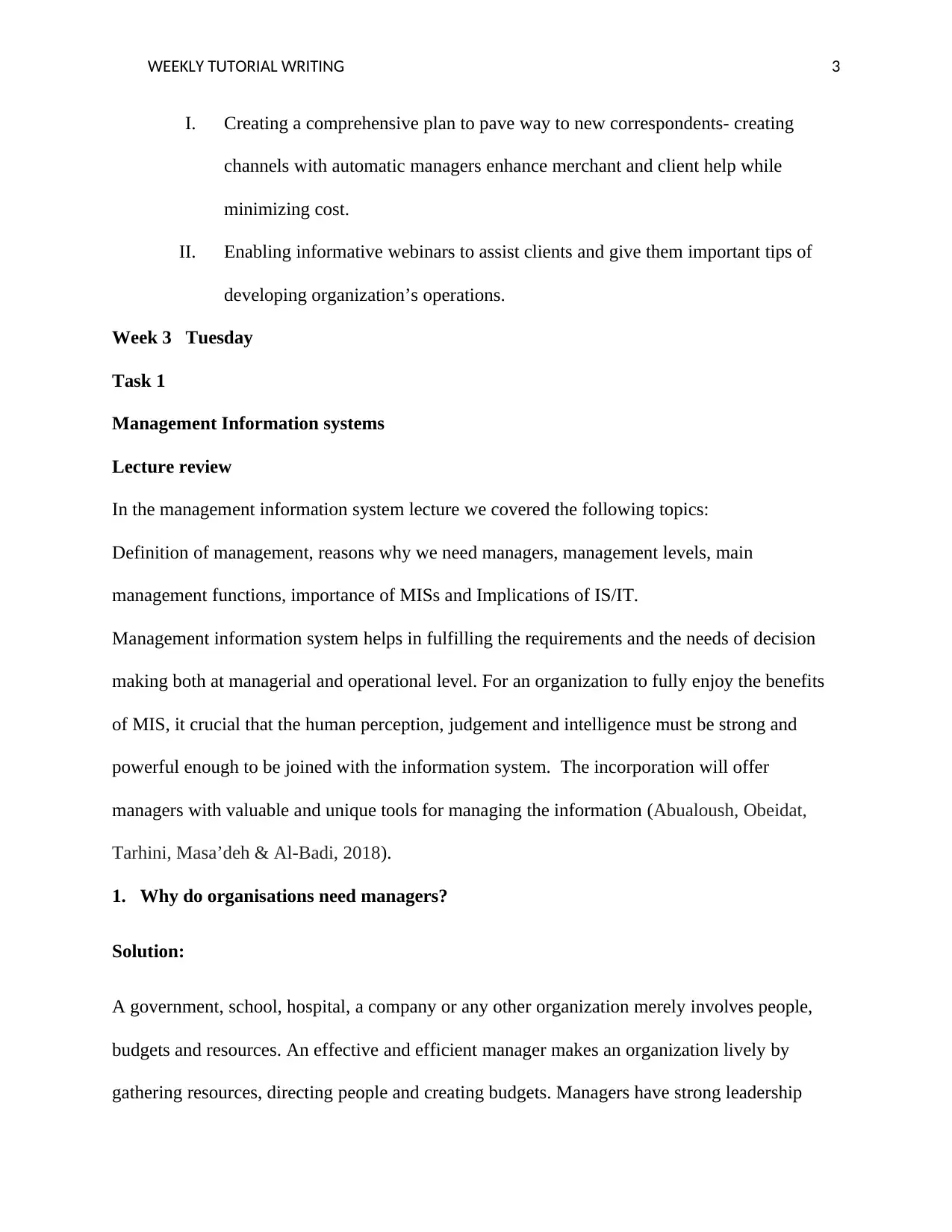
WEEKLY TUTORIAL WRITING 3
I. Creating a comprehensive plan to pave way to new correspondents- creating
channels with automatic managers enhance merchant and client help while
minimizing cost.
II. Enabling informative webinars to assist clients and give them important tips of
developing organization’s operations.
Week 3 Tuesday
Task 1
Management Information systems
Lecture review
In the management information system lecture we covered the following topics:
Definition of management, reasons why we need managers, management levels, main
management functions, importance of MISs and Implications of IS/IT.
Management information system helps in fulfilling the requirements and the needs of decision
making both at managerial and operational level. For an organization to fully enjoy the benefits
of MIS, it crucial that the human perception, judgement and intelligence must be strong and
powerful enough to be joined with the information system. The incorporation will offer
managers with valuable and unique tools for managing the information (Abualoush, Obeidat,
Tarhini, Masa’deh & Al-Badi, 2018).
1. Why do organisations need managers?
Solution:
A government, school, hospital, a company or any other organization merely involves people,
budgets and resources. An effective and efficient manager makes an organization lively by
gathering resources, directing people and creating budgets. Managers have strong leadership
I. Creating a comprehensive plan to pave way to new correspondents- creating
channels with automatic managers enhance merchant and client help while
minimizing cost.
II. Enabling informative webinars to assist clients and give them important tips of
developing organization’s operations.
Week 3 Tuesday
Task 1
Management Information systems
Lecture review
In the management information system lecture we covered the following topics:
Definition of management, reasons why we need managers, management levels, main
management functions, importance of MISs and Implications of IS/IT.
Management information system helps in fulfilling the requirements and the needs of decision
making both at managerial and operational level. For an organization to fully enjoy the benefits
of MIS, it crucial that the human perception, judgement and intelligence must be strong and
powerful enough to be joined with the information system. The incorporation will offer
managers with valuable and unique tools for managing the information (Abualoush, Obeidat,
Tarhini, Masa’deh & Al-Badi, 2018).
1. Why do organisations need managers?
Solution:
A government, school, hospital, a company or any other organization merely involves people,
budgets and resources. An effective and efficient manager makes an organization lively by
gathering resources, directing people and creating budgets. Managers have strong leadership
⊘ This is a preview!⊘
Do you want full access?
Subscribe today to unlock all pages.

Trusted by 1+ million students worldwide
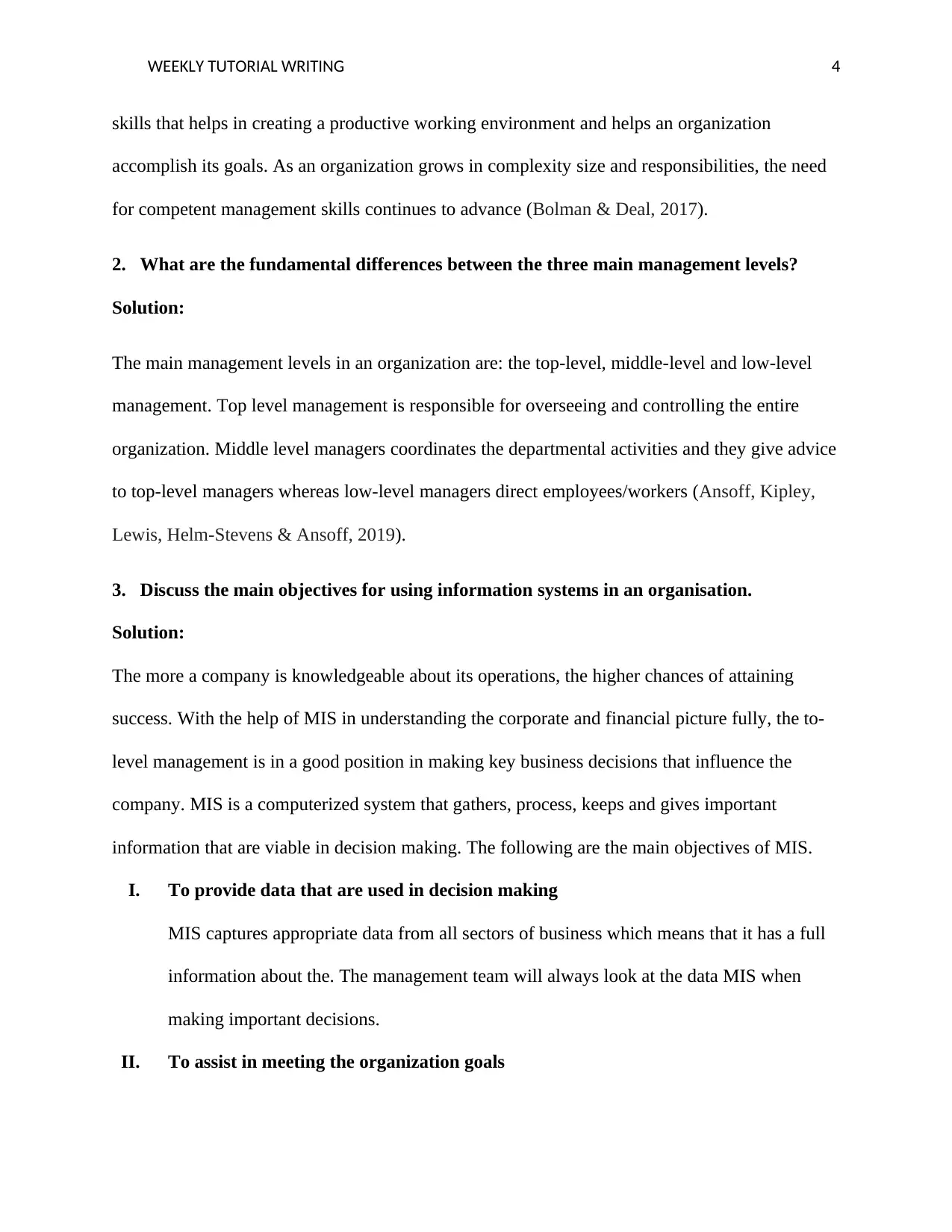
WEEKLY TUTORIAL WRITING 4
skills that helps in creating a productive working environment and helps an organization
accomplish its goals. As an organization grows in complexity size and responsibilities, the need
for competent management skills continues to advance (Bolman & Deal, 2017).
2. What are the fundamental differences between the three main management levels?
Solution:
The main management levels in an organization are: the top-level, middle-level and low-level
management. Top level management is responsible for overseeing and controlling the entire
organization. Middle level managers coordinates the departmental activities and they give advice
to top-level managers whereas low-level managers direct employees/workers (Ansoff, Kipley,
Lewis, Helm-Stevens & Ansoff, 2019).
3. Discuss the main objectives for using information systems in an organisation.
Solution:
The more a company is knowledgeable about its operations, the higher chances of attaining
success. With the help of MIS in understanding the corporate and financial picture fully, the to-
level management is in a good position in making key business decisions that influence the
company. MIS is a computerized system that gathers, process, keeps and gives important
information that are viable in decision making. The following are the main objectives of MIS.
I. To provide data that are used in decision making
MIS captures appropriate data from all sectors of business which means that it has a full
information about the. The management team will always look at the data MIS when
making important decisions.
II. To assist in meeting the organization goals
skills that helps in creating a productive working environment and helps an organization
accomplish its goals. As an organization grows in complexity size and responsibilities, the need
for competent management skills continues to advance (Bolman & Deal, 2017).
2. What are the fundamental differences between the three main management levels?
Solution:
The main management levels in an organization are: the top-level, middle-level and low-level
management. Top level management is responsible for overseeing and controlling the entire
organization. Middle level managers coordinates the departmental activities and they give advice
to top-level managers whereas low-level managers direct employees/workers (Ansoff, Kipley,
Lewis, Helm-Stevens & Ansoff, 2019).
3. Discuss the main objectives for using information systems in an organisation.
Solution:
The more a company is knowledgeable about its operations, the higher chances of attaining
success. With the help of MIS in understanding the corporate and financial picture fully, the to-
level management is in a good position in making key business decisions that influence the
company. MIS is a computerized system that gathers, process, keeps and gives important
information that are viable in decision making. The following are the main objectives of MIS.
I. To provide data that are used in decision making
MIS captures appropriate data from all sectors of business which means that it has a full
information about the. The management team will always look at the data MIS when
making important decisions.
II. To assist in meeting the organization goals
Paraphrase This Document
Need a fresh take? Get an instant paraphrase of this document with our AI Paraphraser

WEEKLY TUTORIAL WRITING 5
One of major purposes of MIS is to give an organization feedback about the performance.
Therefore, MIS assist a business to meet its goals and objectives. Since MIS shows data
of actual performance over planned outcomes, the management have an overview of
where the organization stands on attaining their objectives at any given time.
III. To improve strengths and weakness of an organization
Since MIS keeps data of different aspects of the organization, it has a starting point of
evaluating the areas of business that are succeeding and the ones that need to be
improved.
Task 2
In regards to this statement, I support Team A which argues for IOT because of the following
pros:
1. Cost savings
IOT makes electronic devices to effectively communicate with each other hence it
saves on energy and cost. It helps people in their daily activities to share information
over electronic appliances, it also translates date into a required format.
2.0 Automation and control
Since physical objects are digitally connected and controlled by wireless infrastructure,
this is large amount of control and automation. The machines are able to communicate
effective with each other without any human intervention.
One of major purposes of MIS is to give an organization feedback about the performance.
Therefore, MIS assist a business to meet its goals and objectives. Since MIS shows data
of actual performance over planned outcomes, the management have an overview of
where the organization stands on attaining their objectives at any given time.
III. To improve strengths and weakness of an organization
Since MIS keeps data of different aspects of the organization, it has a starting point of
evaluating the areas of business that are succeeding and the ones that need to be
improved.
Task 2
In regards to this statement, I support Team A which argues for IOT because of the following
pros:
1. Cost savings
IOT makes electronic devices to effectively communicate with each other hence it
saves on energy and cost. It helps people in their daily activities to share information
over electronic appliances, it also translates date into a required format.
2.0 Automation and control
Since physical objects are digitally connected and controlled by wireless infrastructure,
this is large amount of control and automation. The machines are able to communicate
effective with each other without any human intervention.
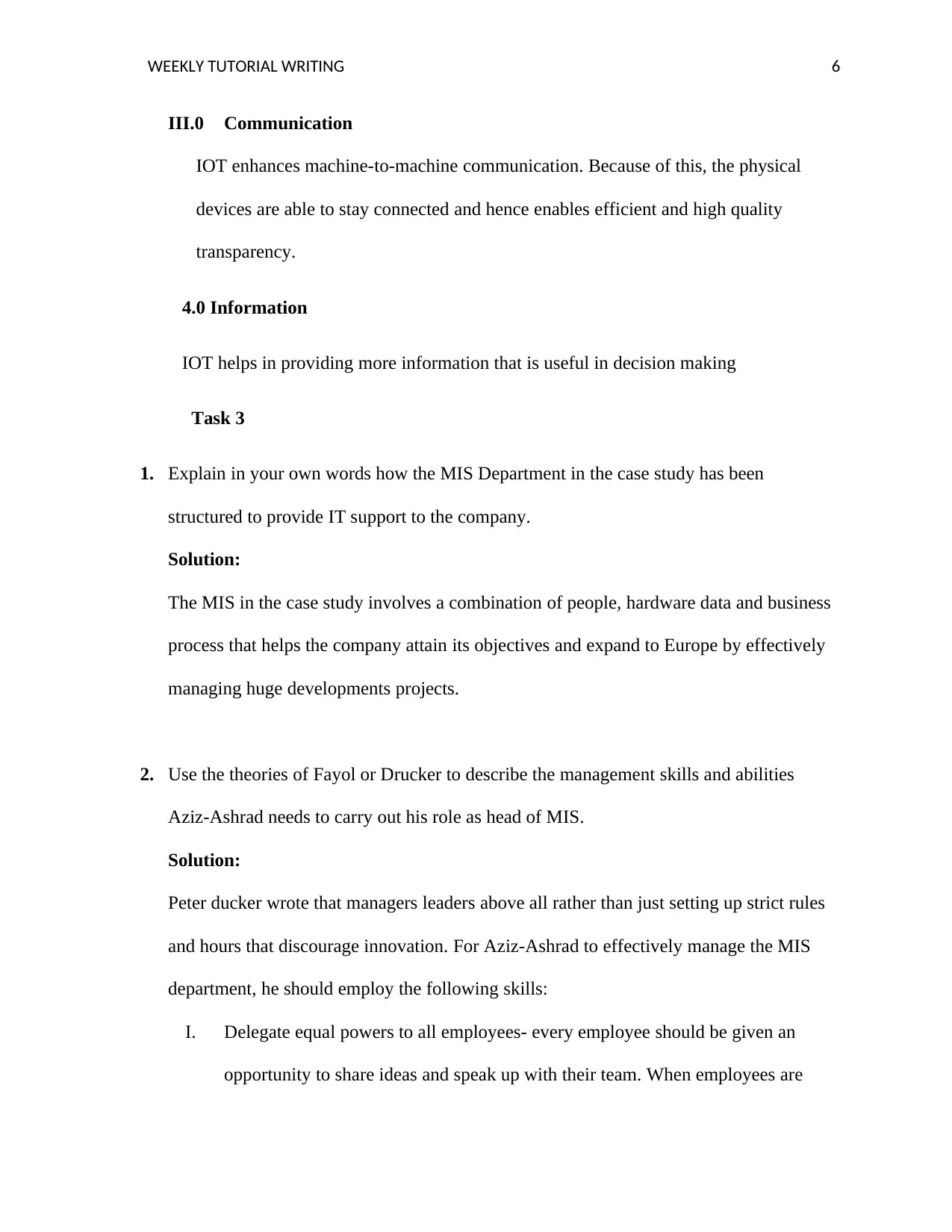
WEEKLY TUTORIAL WRITING 6
III.0 Communication
IOT enhances machine-to-machine communication. Because of this, the physical
devices are able to stay connected and hence enables efficient and high quality
transparency.
4.0 Information
IOT helps in providing more information that is useful in decision making
Task 3
1. Explain in your own words how the MIS Department in the case study has been
structured to provide IT support to the company.
Solution:
The MIS in the case study involves a combination of people, hardware data and business
process that helps the company attain its objectives and expand to Europe by effectively
managing huge developments projects.
2. Use the theories of Fayol or Drucker to describe the management skills and abilities
Aziz-Ashrad needs to carry out his role as head of MIS.
Solution:
Peter ducker wrote that managers leaders above all rather than just setting up strict rules
and hours that discourage innovation. For Aziz-Ashrad to effectively manage the MIS
department, he should employ the following skills:
I. Delegate equal powers to all employees- every employee should be given an
opportunity to share ideas and speak up with their team. When employees are
III.0 Communication
IOT enhances machine-to-machine communication. Because of this, the physical
devices are able to stay connected and hence enables efficient and high quality
transparency.
4.0 Information
IOT helps in providing more information that is useful in decision making
Task 3
1. Explain in your own words how the MIS Department in the case study has been
structured to provide IT support to the company.
Solution:
The MIS in the case study involves a combination of people, hardware data and business
process that helps the company attain its objectives and expand to Europe by effectively
managing huge developments projects.
2. Use the theories of Fayol or Drucker to describe the management skills and abilities
Aziz-Ashrad needs to carry out his role as head of MIS.
Solution:
Peter ducker wrote that managers leaders above all rather than just setting up strict rules
and hours that discourage innovation. For Aziz-Ashrad to effectively manage the MIS
department, he should employ the following skills:
I. Delegate equal powers to all employees- every employee should be given an
opportunity to share ideas and speak up with their team. When employees are
⊘ This is a preview!⊘
Do you want full access?
Subscribe today to unlock all pages.

Trusted by 1+ million students worldwide
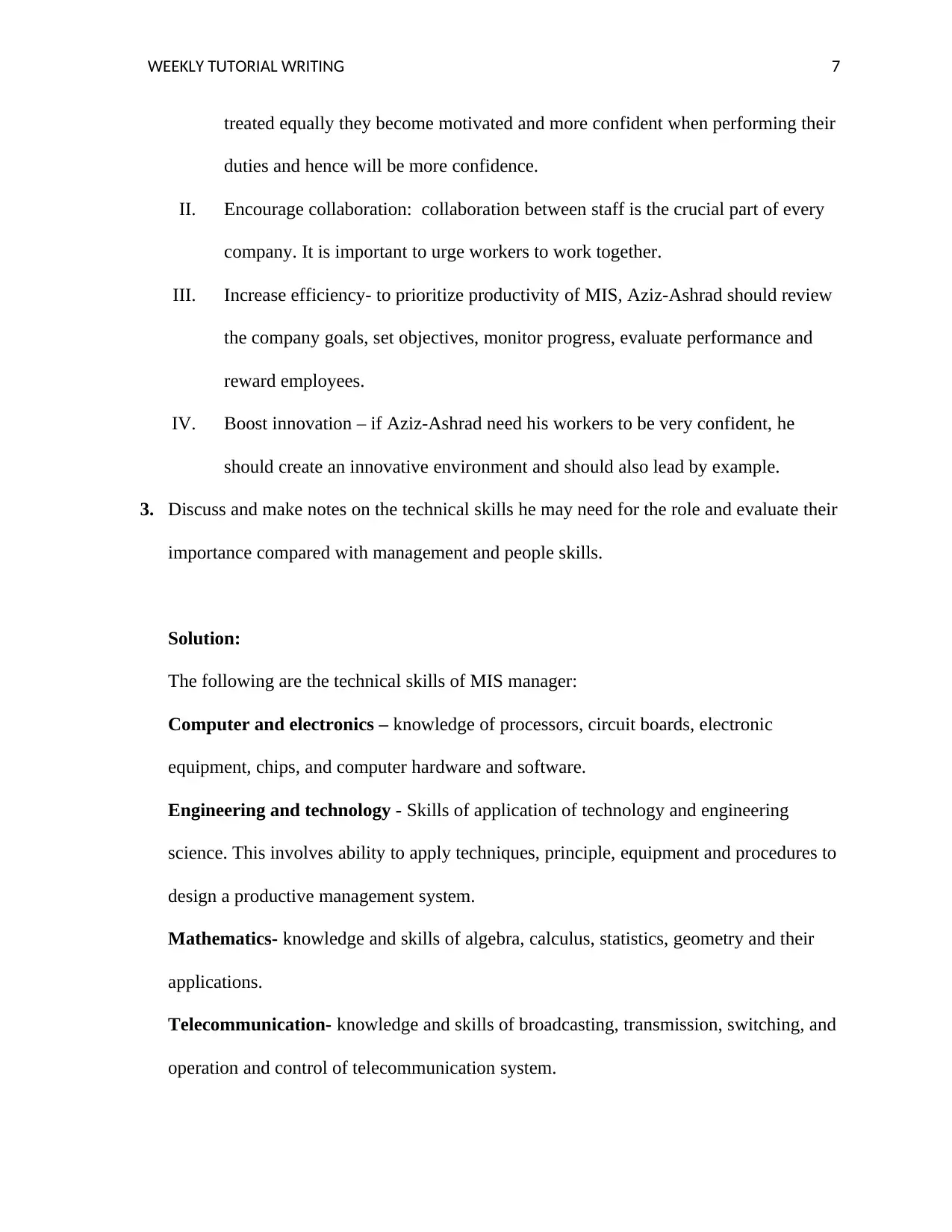
WEEKLY TUTORIAL WRITING 7
treated equally they become motivated and more confident when performing their
duties and hence will be more confidence.
II. Encourage collaboration: collaboration between staff is the crucial part of every
company. It is important to urge workers to work together.
III. Increase efficiency- to prioritize productivity of MIS, Aziz-Ashrad should review
the company goals, set objectives, monitor progress, evaluate performance and
reward employees.
IV. Boost innovation – if Aziz-Ashrad need his workers to be very confident, he
should create an innovative environment and should also lead by example.
3. Discuss and make notes on the technical skills he may need for the role and evaluate their
importance compared with management and people skills.
Solution:
The following are the technical skills of MIS manager:
Computer and electronics – knowledge of processors, circuit boards, electronic
equipment, chips, and computer hardware and software.
Engineering and technology - Skills of application of technology and engineering
science. This involves ability to apply techniques, principle, equipment and procedures to
design a productive management system.
Mathematics- knowledge and skills of algebra, calculus, statistics, geometry and their
applications.
Telecommunication- knowledge and skills of broadcasting, transmission, switching, and
operation and control of telecommunication system.
treated equally they become motivated and more confident when performing their
duties and hence will be more confidence.
II. Encourage collaboration: collaboration between staff is the crucial part of every
company. It is important to urge workers to work together.
III. Increase efficiency- to prioritize productivity of MIS, Aziz-Ashrad should review
the company goals, set objectives, monitor progress, evaluate performance and
reward employees.
IV. Boost innovation – if Aziz-Ashrad need his workers to be very confident, he
should create an innovative environment and should also lead by example.
3. Discuss and make notes on the technical skills he may need for the role and evaluate their
importance compared with management and people skills.
Solution:
The following are the technical skills of MIS manager:
Computer and electronics – knowledge of processors, circuit boards, electronic
equipment, chips, and computer hardware and software.
Engineering and technology - Skills of application of technology and engineering
science. This involves ability to apply techniques, principle, equipment and procedures to
design a productive management system.
Mathematics- knowledge and skills of algebra, calculus, statistics, geometry and their
applications.
Telecommunication- knowledge and skills of broadcasting, transmission, switching, and
operation and control of telecommunication system.
Paraphrase This Document
Need a fresh take? Get an instant paraphrase of this document with our AI Paraphraser

WEEKLY TUTORIAL WRITING 8
Design – skills of design technique, principles and tools that are involve creation of
technical plan, drawings, blueprints and models.
Clerical – knowledge of clerical and administrative procedures and applications like
Microsoft office for managing records, files and designing forms and other procedures in
the office.
4. Imagine that the Human Resources (HR) manager has asked Aziz-Ashrad and his team to
install an automated workflow system to improve the efficiency of the recruitment
process. Why would they need to know about the role of the HR manager and the work of
the HR department before designing the system? What sort of information would be
required? Brainstorm ideas.
Solution
Human resource management systems facilitate quick and efficient interaction between
information technology and human resource management, it is important to know the
functions of HR manager before designing the system because it merges human resource
management discipline and particularly HR processes and activities with the field of
information technology, while programming and planning of data into different functions
needs standard packages and routines of human resource manager. The linkage the functions
of HR manager with the system will make the system to be compatible and flexible to use.
Design – skills of design technique, principles and tools that are involve creation of
technical plan, drawings, blueprints and models.
Clerical – knowledge of clerical and administrative procedures and applications like
Microsoft office for managing records, files and designing forms and other procedures in
the office.
4. Imagine that the Human Resources (HR) manager has asked Aziz-Ashrad and his team to
install an automated workflow system to improve the efficiency of the recruitment
process. Why would they need to know about the role of the HR manager and the work of
the HR department before designing the system? What sort of information would be
required? Brainstorm ideas.
Solution
Human resource management systems facilitate quick and efficient interaction between
information technology and human resource management, it is important to know the
functions of HR manager before designing the system because it merges human resource
management discipline and particularly HR processes and activities with the field of
information technology, while programming and planning of data into different functions
needs standard packages and routines of human resource manager. The linkage the functions
of HR manager with the system will make the system to be compatible and flexible to use.

WEEKLY TUTORIAL WRITING 9
Information required when designing an automated workflow
The design of an automated workflow system begins with identifying of the vital types of
managerial, operational and strategic decisions that is needed by an organization. The decision
flow should be identified and decisions should be well defined. The analysis of the decision flow
will divulge important decisions that are made by default.
Week 3 Thursday
Task 1
1. For each Management Levels discussed in Tuesday’s lecture slides, describe two separate
IT/IS applications for each level.
Solution
Advance Information technology have led to development of systems that managers use
to t make critical business decisions. The following are ways in which IT/IS can been
applied in the three levels of management.
Top-level management
Decision support system – are used by top managers to salvage isolated data items,
estimate consequences of a certain decision, propose and make decisions
Control and evaluation- the managers used IT/IS system to regulate and measure business
operations so as to make sure that they align with the company objectives.
Middle level management
Decisions making – they are used by middle level managers to make decisions of their
department.
Information required when designing an automated workflow
The design of an automated workflow system begins with identifying of the vital types of
managerial, operational and strategic decisions that is needed by an organization. The decision
flow should be identified and decisions should be well defined. The analysis of the decision flow
will divulge important decisions that are made by default.
Week 3 Thursday
Task 1
1. For each Management Levels discussed in Tuesday’s lecture slides, describe two separate
IT/IS applications for each level.
Solution
Advance Information technology have led to development of systems that managers use
to t make critical business decisions. The following are ways in which IT/IS can been
applied in the three levels of management.
Top-level management
Decision support system – are used by top managers to salvage isolated data items,
estimate consequences of a certain decision, propose and make decisions
Control and evaluation- the managers used IT/IS system to regulate and measure business
operations so as to make sure that they align with the company objectives.
Middle level management
Decisions making – they are used by middle level managers to make decisions of their
department.
⊘ This is a preview!⊘
Do you want full access?
Subscribe today to unlock all pages.

Trusted by 1+ million students worldwide
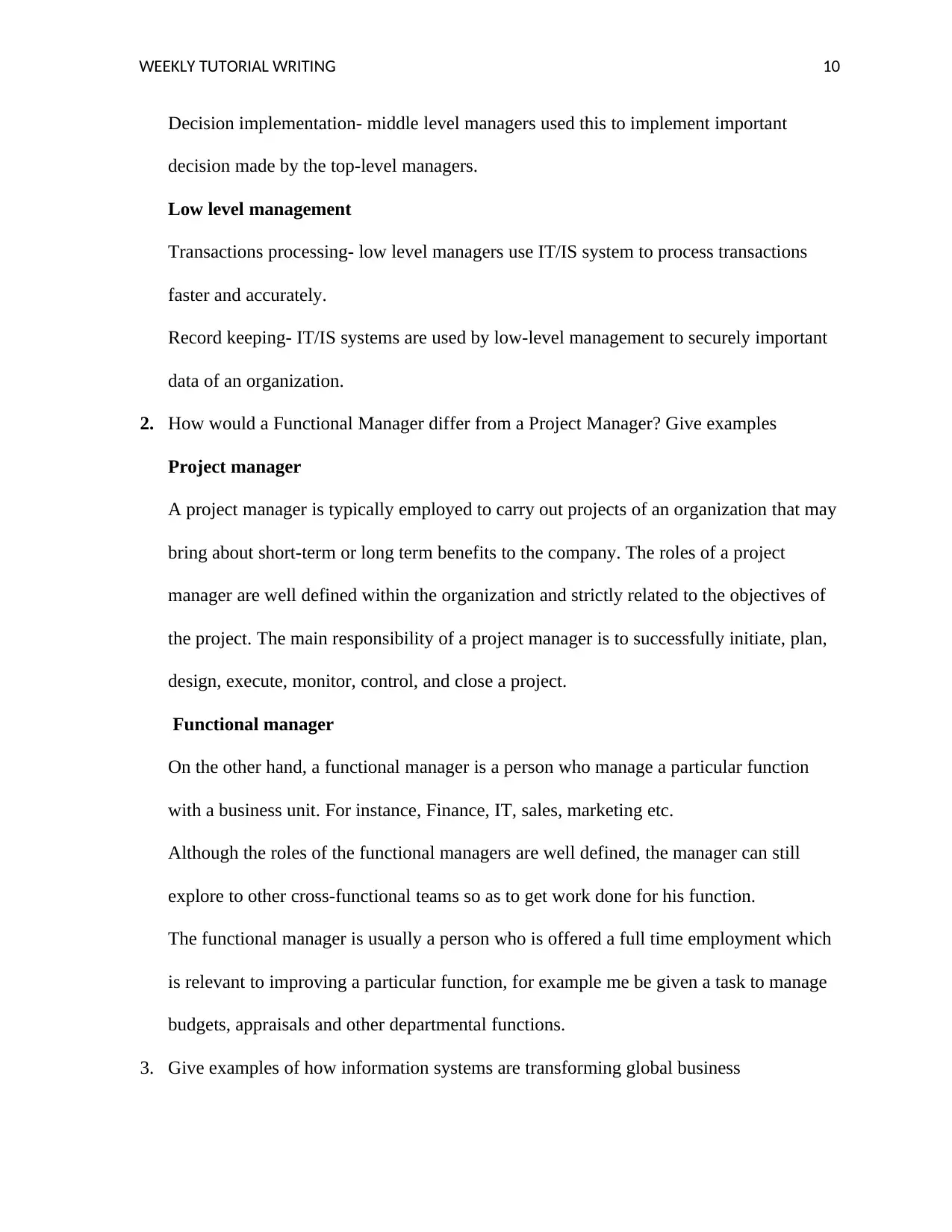
WEEKLY TUTORIAL WRITING 10
Decision implementation- middle level managers used this to implement important
decision made by the top-level managers.
Low level management
Transactions processing- low level managers use IT/IS system to process transactions
faster and accurately.
Record keeping- IT/IS systems are used by low-level management to securely important
data of an organization.
2. How would a Functional Manager differ from a Project Manager? Give examples
Project manager
A project manager is typically employed to carry out projects of an organization that may
bring about short-term or long term benefits to the company. The roles of a project
manager are well defined within the organization and strictly related to the objectives of
the project. The main responsibility of a project manager is to successfully initiate, plan,
design, execute, monitor, control, and close a project.
Functional manager
On the other hand, a functional manager is a person who manage a particular function
with a business unit. For instance, Finance, IT, sales, marketing etc.
Although the roles of the functional managers are well defined, the manager can still
explore to other cross-functional teams so as to get work done for his function.
The functional manager is usually a person who is offered a full time employment which
is relevant to improving a particular function, for example me be given a task to manage
budgets, appraisals and other departmental functions.
3. Give examples of how information systems are transforming global business
Decision implementation- middle level managers used this to implement important
decision made by the top-level managers.
Low level management
Transactions processing- low level managers use IT/IS system to process transactions
faster and accurately.
Record keeping- IT/IS systems are used by low-level management to securely important
data of an organization.
2. How would a Functional Manager differ from a Project Manager? Give examples
Project manager
A project manager is typically employed to carry out projects of an organization that may
bring about short-term or long term benefits to the company. The roles of a project
manager are well defined within the organization and strictly related to the objectives of
the project. The main responsibility of a project manager is to successfully initiate, plan,
design, execute, monitor, control, and close a project.
Functional manager
On the other hand, a functional manager is a person who manage a particular function
with a business unit. For instance, Finance, IT, sales, marketing etc.
Although the roles of the functional managers are well defined, the manager can still
explore to other cross-functional teams so as to get work done for his function.
The functional manager is usually a person who is offered a full time employment which
is relevant to improving a particular function, for example me be given a task to manage
budgets, appraisals and other departmental functions.
3. Give examples of how information systems are transforming global business
Paraphrase This Document
Need a fresh take? Get an instant paraphrase of this document with our AI Paraphraser

WEEKLY TUTORIAL WRITING 11
Solution
Online conferencing, E-mail and mobile phones are becoming an essential tool that are
used to conduct business. IT/IS systems are the basis of fast-paced supply chains. The
internet enable many organization to sell, market and solicit customer’s feedback online.
Many business are looking for ways of becoming more efficient and competitive by
digitalizing core business processes and sprouting into digital corporations. The internet
has enthused globalization by drastically reducing the cost creating, purchasing and
selling of goods and services on global scale. New development trends IT/IS involve the
emergence of cloud computing, online software and mobile digital platforms.
4. Why are IT/IS so essential for running and managing a business today?
Solution
I. It ensure operation excellence – it constantly improve the efficiency of all
business operations that helps it attain maximum profit.
II. New business models and product services- IT/IS systems help businesses to
create a new products and services. New models in business can be created.
III. Supplier and customer intimacy- the better services that are provided by the
company to its consumers, the higher chances of buying from them again and
hence IT/IS provides a good relation to both the organization and the customers.
IV. Improved decision making – IT/IS systems make it possible for a business
managers to utilize data while making decision and hence it makes companies
make viable decisions.
Solution
Online conferencing, E-mail and mobile phones are becoming an essential tool that are
used to conduct business. IT/IS systems are the basis of fast-paced supply chains. The
internet enable many organization to sell, market and solicit customer’s feedback online.
Many business are looking for ways of becoming more efficient and competitive by
digitalizing core business processes and sprouting into digital corporations. The internet
has enthused globalization by drastically reducing the cost creating, purchasing and
selling of goods and services on global scale. New development trends IT/IS involve the
emergence of cloud computing, online software and mobile digital platforms.
4. Why are IT/IS so essential for running and managing a business today?
Solution
I. It ensure operation excellence – it constantly improve the efficiency of all
business operations that helps it attain maximum profit.
II. New business models and product services- IT/IS systems help businesses to
create a new products and services. New models in business can be created.
III. Supplier and customer intimacy- the better services that are provided by the
company to its consumers, the higher chances of buying from them again and
hence IT/IS provides a good relation to both the organization and the customers.
IV. Improved decision making – IT/IS systems make it possible for a business
managers to utilize data while making decision and hence it makes companies
make viable decisions.
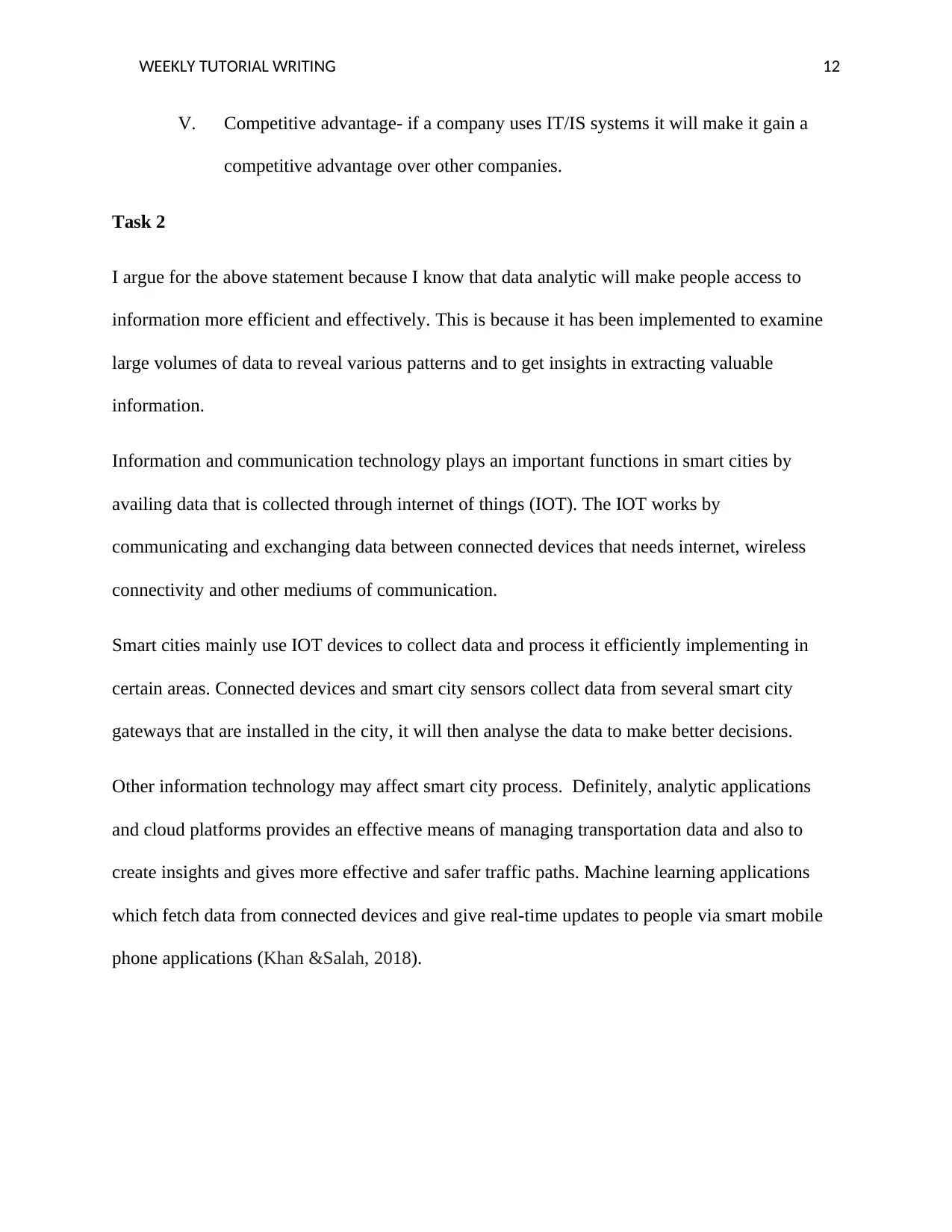
WEEKLY TUTORIAL WRITING 12
V. Competitive advantage- if a company uses IT/IS systems it will make it gain a
competitive advantage over other companies.
Task 2
I argue for the above statement because I know that data analytic will make people access to
information more efficient and effectively. This is because it has been implemented to examine
large volumes of data to reveal various patterns and to get insights in extracting valuable
information.
Information and communication technology plays an important functions in smart cities by
availing data that is collected through internet of things (IOT). The IOT works by
communicating and exchanging data between connected devices that needs internet, wireless
connectivity and other mediums of communication.
Smart cities mainly use IOT devices to collect data and process it efficiently implementing in
certain areas. Connected devices and smart city sensors collect data from several smart city
gateways that are installed in the city, it will then analyse the data to make better decisions.
Other information technology may affect smart city process. Definitely, analytic applications
and cloud platforms provides an effective means of managing transportation data and also to
create insights and gives more effective and safer traffic paths. Machine learning applications
which fetch data from connected devices and give real-time updates to people via smart mobile
phone applications (Khan &Salah, 2018).
V. Competitive advantage- if a company uses IT/IS systems it will make it gain a
competitive advantage over other companies.
Task 2
I argue for the above statement because I know that data analytic will make people access to
information more efficient and effectively. This is because it has been implemented to examine
large volumes of data to reveal various patterns and to get insights in extracting valuable
information.
Information and communication technology plays an important functions in smart cities by
availing data that is collected through internet of things (IOT). The IOT works by
communicating and exchanging data between connected devices that needs internet, wireless
connectivity and other mediums of communication.
Smart cities mainly use IOT devices to collect data and process it efficiently implementing in
certain areas. Connected devices and smart city sensors collect data from several smart city
gateways that are installed in the city, it will then analyse the data to make better decisions.
Other information technology may affect smart city process. Definitely, analytic applications
and cloud platforms provides an effective means of managing transportation data and also to
create insights and gives more effective and safer traffic paths. Machine learning applications
which fetch data from connected devices and give real-time updates to people via smart mobile
phone applications (Khan &Salah, 2018).
⊘ This is a preview!⊘
Do you want full access?
Subscribe today to unlock all pages.

Trusted by 1+ million students worldwide
1 out of 41
Related Documents
Your All-in-One AI-Powered Toolkit for Academic Success.
+13062052269
info@desklib.com
Available 24*7 on WhatsApp / Email
![[object Object]](/_next/static/media/star-bottom.7253800d.svg)
Unlock your academic potential
Copyright © 2020–2025 A2Z Services. All Rights Reserved. Developed and managed by ZUCOL.



